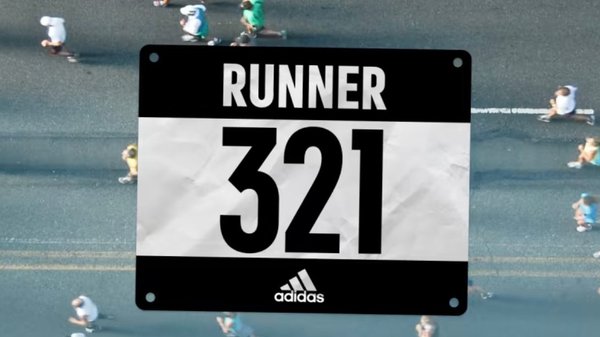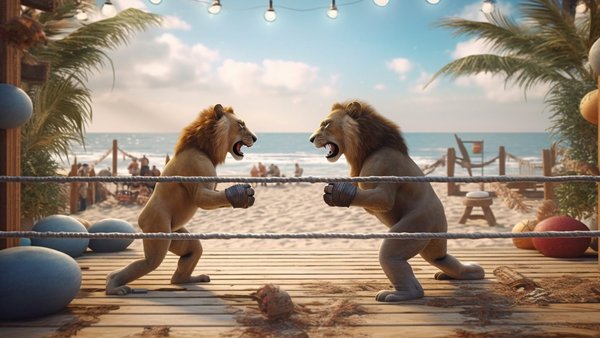Contagious Cannes Contenders 2019 (part one) /
Ahead of the Cannes Lions festival, the Contagious team has picked our favourite campaigns of the year

At Contagious, we spend all day, every day looking at, thinking about and analysing creative marketing, so we have some pretty strong opinions about what we think should win at this year's Cannes Lions festival. Here, the Contagious team shares a few of our favourite campaigns, from the ones that are sure to pick up the Grands Prix to the lesser-known underdogs that we would be fighting for if we were on a Cannes Lions jury.
For more Contagious team picks, read part two of our Cannes Contenders here.
Alex Jenkins / Editorial Director /
Volkswagen / Unfail
My hot tip this year has all the buzzwords: millennials, viral video, retargeting. And if you think Cannes is just a parade of tech and novelty, that alone should convince you that it's a shoo-in for all the awards. Now let me convince the rest of you...
Last year, a video surfaced online of two young chumps rolling one of their friends down a hill inside a tyre tube. The tyre careens wildly, bouncing across a road, causing a VW Polo to make an emergency stop, before splashing down in a pool of water.
A film of the near-miss racked up over 46 million views and achieved over $17m in earned media. And then the smart bit kicked in. A few days later, Volkswagen posted a new video, retargeted to viewers of the original, revealing that the stunt was a hoax to promote the Polo’s emergency city brake feature. DDB Sydney and Riot Content, the agencies behind the campaign, report an 8.2% increase in safety attribution and an 11.8% increase in market share.
An old-fashioned product demo run on a media-earning viral video is pretty good. But an actual creative use of retargeting? Someone deserves an award for that.
Bonus tip: If Childish Gambino’s This is America video gets entered in Entertainment for Music, it wins.
Phoebe O’Connell / Writer / Researcher /
The New York Times / The Truth Is Worth It
I defy anyone to watch any of the short films from The New York Times’ The Truth Is Worth It campaign, and not be moved/horrified/incensed/all of the above.
The latest spots, created by Droga5 New York, reveal the lengths journalists have gone to in order to uncover some of the most significant news stories of the past few years. A film called Persistence tracks the efforts of Caitlin Dickerson, the national immigration reporter who proved that immigrant children were being separated from their parents at US borders last year, while another called Resolve gives a glimpse into Hannah Beech’s chilling and Pulitzer Prize-winning investigation into the ethnic cleansing of the Rohingya in Myanmar.
Each ad highlights the dedication and bravery of reporters in their pursuit of the truth, against the sound of ominous music dotted with dial tones and voice recordings, as shots of warzone rubble and traumatised children flash across the screen.
Faced with declining print sales, growing public distrust and ‘post-truth’ worming its way into the Oxford Dictionary, the publication found a powerful way to remind us of the value of high-quality journalism and the pursuit of truth.
Paul Kemp-Robertson / Contagious Founder and Chief Brand Officer /
Ruavieja / We Have To See More Of Each Other
Maybe it’s because I spent six years at Leo Burnett and had to vote on stacks of Hallmark commercials at the agency’s quarterly creative councils, but I’m an absolute sucker for ads that go straight and unashamedly for the emotional jugular. Throw in the fact that I lost both my mother and mother-in-law to Alzheimer’s disease recently, and it came as no surprise that Ruavieja’s We Have To See More Of Each Other campaign left me a snotty, blubbering wreck.
Based on the insight that the pace of modern life and the dopamine pull of technology is jeopardising the bonds between people, this Spanish liquor brand urged us to spend more time with our loved ones. Collaborating with Publicis Groupe's Advanced Analytics team, Leo Burnett Madrid created an algorithm based on data supplied by the Spanish Institute for Statistics. It allowed the agency to calculate how little time people have left to spend with those they love before one of them dies. The campaign was launched with an online video and prime-time commercial that capitalised on pre-Christmas sentiment. The spots featured the shocked reactions of close friends and relatives when confronted with the estimated remaining hours they had left with loved ones. Carpe Bloody Diem.
Framing the campaign as a social experiment could count against it, as jurors may point to a recent raft of purpose-driven tear duct-tuggers like TV2 Denmark’s All That We Share, Dove’s Real Beauty Sketches and Heineken's Worlds Apart. But the Spanish-version of Ruavieja's film sparked 10 million views on YouTube within its first week, and 500,000 people took the online quiz – suggesting the exercise touched a nerve. By starting a socio-cultural conversation that stopped people in their tracks, Ruavieja traded obscurity for fame.
Contagious members can read our interview with the general creative director at Leo Burnett, Madrid, to find out the insight and strategy behind the campaign.
Chris Barth / Lead Strategist /
Nike / Dream Crazy & Dream Crazier
Perhaps the only truly iconic campaign to come out of the past year, Nike’s Dream Crazy/Dream Crazier spots are sure to take home hardware in Cannes. The Wieden+Kennedy work is reminiscent of grand Lions of yore like Dove Beauty Sketches and REI’s #OptOutside – executions that are true to the brand, articulating ideas that feel simultaneously timeless and incredibly of the moment. Expect this to be near the top of Film, Glass, Titanium and more (and to be talked about on the mainstage no fewer than 15 times during the course of the week).
It’s more than talk, though. It’s putting your money where your mouth is. Continuing to sponsor a lightning-rod player like Colin Kaepernick, even after he has been blackballed from the NFL, is a move only done by a brand that understands its values. Shouting it from the rooftop is a move only done by a brand that isn’t afraid to stand by those values even if it means losing a few customers. Nike isn’t perfect (few brands are) but it understands itself incredibly well.
Gallons of ink have already been spilled on Dream Crazy/Crazier, with more sure to come, so I’ll keep the takeaway brief. If you’re considering ruffling some feathers in defence of your values: just do it.
Sunil Bajaj / Writer /
Skittles / Broadway the Rainbow
Move over Hamilton, there’s a new cat in town. Which cat? Oh, it’s Michael C Hall, Golden Globe-winning actor of Dexter, live on stage in New York earlier this year for one night only in… Skittles Commercial: The Musical!
For the campaign, Broadway the Rainbow, DDB New York opted out of the conventional Super Bowl half-time strategy, which usually consists of paying $millions for a 30-second TV ad, which would reach over 100 million viewers. Instead, DDB and Skittles would target a more modest 1,500 people by creating a 45-minute-long musical, which would cost the consumer $200 a ticket to attend. This bold strategy earned Skittles $300,000 in box office revenue from a captivated audience, along with 2.5 billion impressions and $50m in earned media
Skittles has built a reputation for curating wonderfully chaotic ideas, but the self-referential fourth-wall breaking Broadway the Rainbow might be its most ambitious yet. Spending months on planning and rehearsals, creating original music, merchandise and an official programme, the effort here is very much noticed and if you missed it, you missed out, with the ad to never be shown on TV or the web.
Cannes Lions is all about rewarding the best work in creativity from across the globe. Not only did Skittles hijack attention away from its competitors who paid millions for their half-time advertising space, but also created a piece of content that was lauded by audiences and critics alike.
I fancy Skittles’ odds at Cannes, but if not, I’m sure it’ll clean up at the Tonys.
Contagious members can log in to read our interview with Ari Weiss, North American CCO at DDB, on the insight and strategy behind creating an advertising musical here.
Jason Drys / Researcher / Strategist /
Domino’s Pizza / Paving for Pizza
I never thought I would get hooked on the idea of a pizza company fixing potholes. However, almost a year after its original launch, the Paving for Pizza campaign continues to amaze me, one pothole at a time.
Domino’s, working with Crispin Porter + Bogusky, Boulder, launched a website asking people to nominate a US city or town they’d like to receive a paving grant to repair cracks in roads and fill in potholes. Things got exciting when people loved the idea, nominating almost every county and resulting in one billion media impressions within a month of launch.
So, Domino’s went all in – trucks, shovels and cement – for the holy purpose of pizza perfection. (The pizza brand has said that it started the campaign so pizzas wouldn't be spoiled by people driving over bumpy roads.) Every fixed pothole featured the Domino’s logo sprayed on the road surface next to the brand’s signature ‘Oh Yes We Did’ message for the world to see. As of today, the pizza company has repaired 950 potholes and counting, with 15 more counties due to have Domino’s branding on local streets before 2020.
A JP Morgan Analyst once said ‘We’ve recently found ourselves describing Domino’s as a pizza-delivering company, disguised as a marketing company, disguised as an ecommerce business.’ Now that you can add ‘pothole-fixing service’ to the list I think we need a shorter way to describe the kind of company Domino’s is: freaking awesome.
Contagious members can read our Insight & strategy interview with D’Arcy O’Neill, creative director at CP+B, Boulder, to find out why Domino’s branched out into public infrastructure.
George Wyndham / Staff Writer /
Microsoft / Changing the Game
Seriously. Brands need to stop calling themselves ‘inclusive’ unless they can back it up. And no, parading people of different ethnic origins in marketing campaigns doesn’t count as inclusive. This nonsense doesn’t hold water with today’s consumer and frankly it’s meaningless. Inclusivity - if it's important to a brand - should be at the core of everything it says and does, manifesting across product, service, experience and communications. It’s amazing how many brands get this wrong.
That is why I was so impressed with Microsoft’s Xbox Adaptive Controller, a device painstakingly crafted to meet the needs of gamers with disabilities. Microsoft already has strong diversity credentials from tech it has developed in the past, but this went the extra mile. The development of the controller was, by all accounts, incredibly arduous. Well, it was worth it. The result is an astonishing piece of engineering and a deeply moving TV spot that killed it at the Super Bowl (nice one, McCann New York).
While being warm and fuzzy, there was an underlying commercial rationale too. Disabled gamers are a powerful demographic (the charity AbleGamers reckons there are more than 30 million of them in the US alone) and represent a slew of potential new customers for Microsoft. As well as a massive injection of positive brand sentiment, Microsoft’s campaign will have other gaming companies kicking themselves while they scramble to introduce their own accessible hardware. For these reasons, I’m willing to put money on this campaign doing well at Cannes. Game on!
If you'd like us to bring the best work, key trends and brightest ideas from Cannes Lions to your office for your team or as part of a client event, book our Cannes Deconstructed briefing. Based on behind-the-scenes access to jury presidents, press conferences and the teams behind the Grands Prix-winning work, Cannes Deconstructed delivers a week’s worth of Cannes in one, insight-packed hour. To find out more or book a Contagious Cannes Deconstructed briefing, click here.
Want more of the same? /
We don’t just write about best-in-class campaigns, interviews and trends. Our Members also receive access to briefings, online training, webinars, live events and much more.







